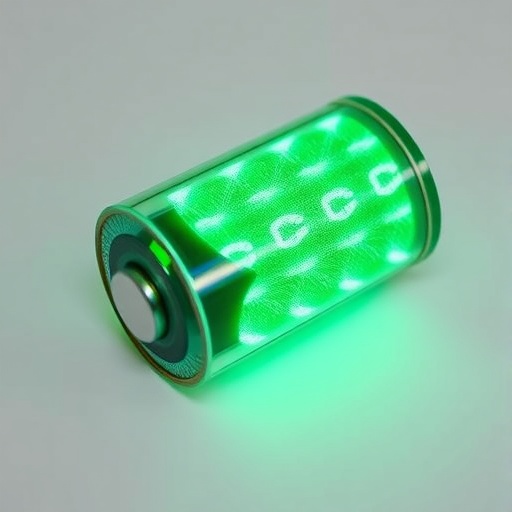In the relentless pursuit of advanced energy storage solutions, organic electrode materials have emerged as a promising frontier. Their inherent versatility, sustainability, and potential cost-effectiveness position them as attractive alternatives to traditional transition metal oxide electrodes in lithium-ion battery technology. However, despite their advantages, these organic electrodes have long been dogged by significant limitations—namely, low operating voltages and poor cycling stability. These challenges have hindered their widespread adoption in commercial battery applications, especially in the context of all-solid-state battery systems, where mechanical stability and long-term performance are critical.
A recent breakthrough study, published in Nature Chemistry, introduces an innovative approach that promises to overhaul the landscape of organic electrode materials. By pioneering a solid solvation structure design, the researchers have engineered a new cathode system that sharply enhances both voltage output and cycling durability. This leap is achieved through a meticulous orchestration of molecular interactions within a solid-state matrix, yielding a homogeneous solid cathode solution that operates efficiently under ambient conditions.
At the heart of this pioneering work lies the strategic deployment of halide electrolytes as solid solutes coupled with tetrachloro-o-benzoquinone, a chlorinated quinone derivative, serving as the solid solvent. This unconventional pairing forms what the authors dub an “asymmetric solid solvation sheath.” Within this environment, the tetrachloro-o-benzoquinone is not merely a passive host but actively participates in the stabilization and modulation of the electrochemical environment. This molecular assembly coalesces into a uniform cathode phase that facilitates superior ionic transport and electrochemical activity.
.adsslot_fruI0Nikjn{ width:728px !important; height:90px !important; }
@media (max-width:1199px) { .adsslot_fruI0Nikjn{ width:468px !important; height:60px !important; } }
@media (max-width:767px) { .adsslot_fruI0Nikjn{ width:320px !important; height:50px !important; } }
ADVERTISEMENT
Central to the device’s enhanced performance is its ability to achieve a high working voltage—approximately 3.6 volts versus Li⁺/Li at room temperature. This voltage is noteworthy for organic electrodes, which traditionally operate at significantly lower potentials, thus limiting the overall energy density of organic-based batteries. Achieving such a high voltage in an all-solid-state configuration is particularly impressive, as it opens pathways for safer, more energy-dense solid-state organic batteries that may rival their inorganic counterparts.
The research team meticulously optimized the inner solvation configuration, tuning interactions at the molecular level to stabilize key redox intermediates and facilitate charge transfer. This optimization process entailed systematic exploration of various halide salts and their interactions with the chlorinated quinone framework, carefully balancing electrostatic and solvation forces. This fine-tuning ensures spatiotemporal coherence in ionic and electronic transport, a prerequisite for consistent battery operation over extended cycles.
The demonstration battery showcases performance metrics that stand out not only for organic systems but even in the broader all-solid-state battery landscape. The successful integration of the solid solvation sheath allows for stable operation over thousands of cycles with minimal capacity fade, a feat rarely accomplished by organic electrode systems. This durability is attributed to the suppression of dendritic lithium growth and interfacial impedance build-up, common failure pathways in solid-state battery architectures.
Material sustainability and cost considerations further enhance the appeal of this solid solvation strategy. Organic electrode components can be synthesized from abundant, non-toxic precursors and circumvent the reliance on scarce transition metals such as cobalt and nickel. The use of chlorinated quinones and halide salts aligns well with scalable chemical processes and could lead to environmentally benign battery production pipelines.
From a broader perspective, the work introduces a fundamental shift in the way organic electrodes are conceptualized for solid-state applications. By exploiting the principles of solvation chemistry in the solid phase, the researchers have unlocked performance gains that were previously achievable only with liquid electrolytes or complex composite structures. This insight opens fertile ground for the design of next-generation batteries where organic materials are tailored at the molecular level for optimal electrochemical and mechanical properties.
Future research inspired by this breakthrough will likely explore the extension of solid solvation strategies to other classes of organic redox-active molecules. Expanding the scope beyond tetrachloro-o-benzoquinone could yield a portfolio of high-voltage, durable electrode materials with tunable properties, enabling battery designs customized for specific applications such as electric vehicles, grid storage, or wearable electronics.
Moreover, integrating these organic electrodes with advanced solid electrolytes that are compatible with the asymmetric solid solvation structure will be critical. Synergistic development of electrolyte chemistry and electrode architecture will ensure maximized ionic conduction and minimized interface degradation, further enhancing battery safety and longevity.
The implications of the study also resonate with broader sustainability goals in energy technology. The shift towards organic, metal-free electrodes aligns with reducing the environmental and geopolitical concerns associated with mining and refining scarce transition metals. Thus, the solid solvation structure design not only advances battery science but also contributes to a more sustainable energy landscape.
In summary, this pioneering research represents a transformative step forward in all-solid-state battery technology. By crafting a carefully balanced solid solvation sheath that enhances the electrochemical environment of organic electrode materials, the authors have effectively shattered longstanding barriers related to voltage output and cycling stability. Their work charts a compelling pathway towards practical, durable, and sustainable organic batteries poised to redefine energy storage paradigms.
The confluence of higher voltages, rapid redox kinetics, and self-healing interface dynamics consolidates a new design principle for organic electrodes in solid-state systems. Such advances highlight the profound potential of molecular-level engineering in addressing grand challenges in rechargeable battery technology, heralding a future where organic ingredients power the next energy revolution with impressive efficiency and resilience.
—
Subject of Research: Solid solvation structure design for enhancing voltage and cycling stability in all-solid-state organic lithium-ion batteries
Article Title: Solid solvation structure design improves all-solid-state organic batteries
Article References:
Hu, Y., Su, H., Fu, J. et al. Solid solvation structure design improves all-solid-state organic batteries.
Nat. Chem. (2025). https://doi.org/10.1038/s41557-025-01866-0
Image Credits: AI Generated
Tags: advanced energy storage systemsall-solid-state batterieschlorinated quinone derivativescycling stability improvementsenhanced voltage outputhalide electrolytes in batteriesinnovative cathode designmolecular interactions in batteriesorganic electrode materialssolid solvation structuresolid-state battery technologysustainable energy storage solutions





